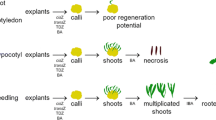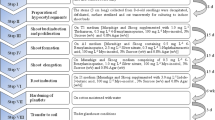Abstract
An efficient protocol for spinach (Spinacia oleracea L.) plant regeneration from hypocotyl and root segments was established. When the sub-apical hypocotyl and tip-free root segments were cultured on Murashige & Skoog (1962)-based medium containing high concentrations of indole-3-acetic acid (85.62 μM) and gibberellic acid (100 μM), more than 75% and 90% of the hypocotyl and root explants, respectively, formed shoots. After elongation, more than 92% of the shoots rooted on medium supplemented with 2.85–5.71 μM of indole-3-acetic acid. More than 70% of rooted plantlets survived in soil and were fertile. Significant interactions between growth regulator combinations, explant types and environmental conditions on shoot initiation, development and rooting were discussed.
Similar content being viewed by others
Abbreviations
- BA:
-
benzyladenine
- BM:
-
Murashige & Skoog basal medium
- B5:
-
Gamborg et al. medium (1968)
- 2,4-d :
-
2,4-dichlorophenoxyacetic acid
- 2ip:
-
isopentenyladenine
- GA3 :
-
gibberellic acid
- IAA:
-
indole-3-acetic acid
- MS:
-
Murashige & Skoog medium (1962)
- NAA:
-
naphthaleneacetic acid
- HS:
-
hypocotyl segments
- RSS:
-
root segments of seedlings
- RSV:
-
foot segments of in vitro plantlets
References
Al-Khayri JM, Huang FH & Morelork TE (1991) Regeneration of spinach from leaf callus. HortScience 26: 913–914
Al-Khayri JM, Huang FH, Morelork TE & Busharara TA (1992) Spinach tissue culture improved with coconut water. HortScience 27: 357–358
Dalton CC & Street HE (1976) The role of the gas phase in the greening and growth of illuminated cell suspension cultures of spinach (Spinacia oleracea L.). In Vitro 12: 485–494
DeGreef W & Jacobs M (1979) In vitro culture of the sugarbeet: description of a cell line with high regeneration capacity. Plant Sci. Lett. 17: 55–61
Fry SC & Street HE (1980) Gibberellin-sensitive suspension cultures. Plant Physiol. 65: 472–477
Gamborg OL, Miller RA & Ojima K (1968) Plant cell cultures. I. Nutrient requirements of suspension cultures of soybean root cells. Exp. Cell Res. 50: 151–158
Hathway DE (1990) Plant growth and development in molecular perspective. Biol. Rev. 65: 473–515
Mackenzie IA & Street HE (1970) Studies on the growth in culture of plant cells. VIII. The products of ethylene by suspension cultures of Acer pseudoplatanus L.. J. Exp. Bot. 21: 824–834
Mii M, Okuda K & Iizuka M (1987) Plantlet regeneration from the hypocotyl segments of Spinacia oleracea. Japan. J. Breed. 37 (suppl. 2): 24–25
Mii M, Nakano M, Okuda K & Iizuka M (1992) Shoot regeneration from spinach hypocotyl segments by short term treatment with 5,6-dichloro-indole-3-acetic acid. Plant Cell Rep. 11: 58–61
Murashige T & Skoog F (1962) A revised medium for rapid growth and bioassay with tobacco tissue cultures. Physiol. Plant. 15: 473–497
Neskovic M & Radojevic L (1973) The growth of and morphogenesis in tissue cultures of Spinacia oleracea L.. Bull. de l'Inst. et du Jardin Bot. de l'Univ. de Béograd VIII Ser. 1–4: 35–37
Nitsch JP (1969) Experimental androgenesis in Nicotiana. Phytomorph. 19: 389–404
Pua EC, Chi GL & Barfield DG (1990) Effects of ethylene on plant regeneration from seedling explants and somatic embryogenesis of recalcitrant genotypes in Cruciferae. Abstracts, VIIth IAPTC Congress, Amsterdam, The Netherlands (p 284)
Sasaki H (1989) Callus and organ formation in tissue cultures of spinach (Spinacia oleracea L.). J. Japan. Soc. Hort. Sci. 58: 149–153
Sasaki H, Nakai S & Kubouchi H (1986) Organ formation of spinach hypocotyl tissues cultured in vitro. J. Hokkaido Univ. Educ. (IIB) 37: 49–56
Sasaki H, Saito Y & Yada H (1987) Adventitious bud formation of spinach hypocotyl tissues cultured in vitro. J. Hokkaido Univ. Educ. (IIB) 38: 1–9
Sasaki H, Ohta M & Ono M (1989) Effects of gibberellin concentrations and cultivars on adventitious bud formation of spinach hypocotyl tissues cultured in vitro. J. Hokkaido Univ. Educ. (IIB) 40: 73–80
Xiao XG (1994) Contribution to in vitro plant regeneration of spinach (Spinacia oleracea L.) to obtain plants with new agronomic characteristics. Ph. D. Thesis University of West Brittany, France (p 199)
Xiao XG & Branchard M (1993) Embryogenesis and plant regeneration of spinach (Spinacia oleracea L.) frorn hypocotyl segments. Plant Cell Rep. 13: 69–71
Xiao XG, Barreneche T & Branchard M (1993) Factors influencing somatic embryogenesis and plant regeneration of spinach (Spinacia oleracea L.). Abstracts, XIIe Colloque de la section française de l'IAPTC, Nov. Montpellier, France (p 76)
Author information
Authors and Affiliations
Rights and permissions
About this article
Cite this article
Xiao, Xg., Branchard, M. In vitro high frequency plant regeneration from hypocotyl and root segments of spinach by organogenesis. Plant Cell Tiss Organ Cult 42, 239–244 (1995). https://doi.org/10.1007/BF00029993
Received:
Accepted:
Issue Date:
DOI: https://doi.org/10.1007/BF00029993




